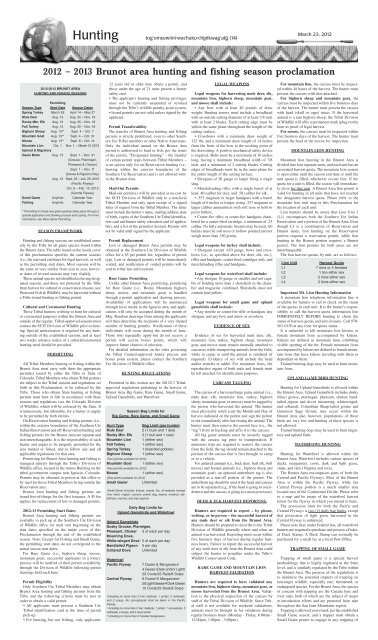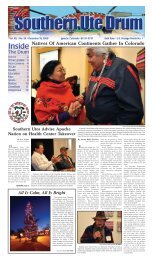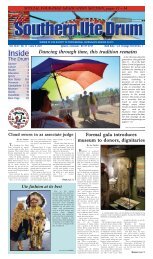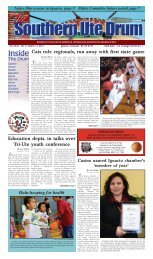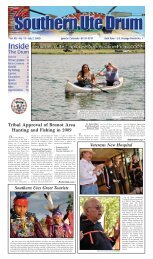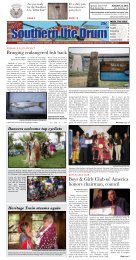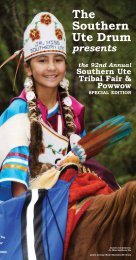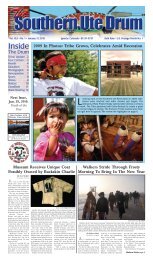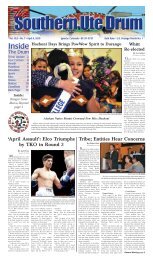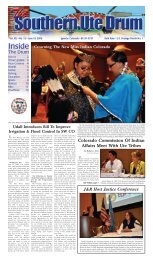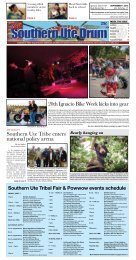winner of four native american journalists association awards
winner of four native american journalists association awards
winner of four native american journalists association awards
Create successful ePaper yourself
Turn your PDF publications into a flip-book with our unique Google optimized e-Paper software.
March 23, 2012<br />
Hunting tog’omsuwiini-wachuku-chipikwag’atü (14)<br />
2012 – 2013 Brunot area hunting and fishing season proclamation<br />
2012-2013 BRUNOT AREA<br />
HUNTING AND FISHING SEASONS<br />
Permitting<br />
Season Type Start Date Season Dates<br />
Spring Turkey March 26 April 14 – May 27<br />
Mule Deer Aug. 13 Aug. 25 – Nov. 18<br />
Rocky Mtn. Elk Aug. 13 Aug. 25 – Nov. 18<br />
Fall Turkey Aug. 13 Aug. 25 – Nov. 18<br />
Bighorn Sheep Aug. 13** Sept. 4 – Oct. 7<br />
Mountain Goat Aug. 13** Sept. 4 – Oct. 31<br />
Moose Aug. 13** Sept. 8 – Oct. 14<br />
Mountain Lion Oct. 1 Nov. 1, – March 31 2013<br />
Upland & Migratory<br />
Game Birds Aug. 13 Sept. 1 – Dec. 31<br />
(Grouse, Ptarmigan,<br />
Pheasant & Chukar)<br />
Sept. 1 – Nov. 11<br />
(Doves & Pigeons Only)<br />
Waterfowl Aug. 13 Sept. 22 – Jan. 29, 2013<br />
(Pacific Flyway)<br />
Oct. 6 – Feb. 10, 2013<br />
(Central Flyway)<br />
Small Game Anytime Calendar Year<br />
Fishing Anytime Calendar Year<br />
**Permitting for these rare game species takes place through a<br />
special application and drawing process each spring. For more<br />
information, see Rare Game Permitting.<br />
SEASON FRAMEWORK<br />
Hunting and fishing seasons are established annually<br />
by the Tribe for all game species found within<br />
the Brunot Area. The table found on the inside cover<br />
<strong>of</strong> this proclamation specifies the current seasons<br />
(i.e., the start and end dates for legal harvest), as well<br />
as the permitting start dates. Most seasons will be<br />
the same or very similar from year to year, however,<br />
dates <strong>of</strong> several seasons may vary slightly.<br />
Those animal species not identified as having designated<br />
seasons, and those not protected by the Tribe<br />
from harvest for cultural or conservation reasons (see<br />
Protected Fish & Wildlife), may be harvested without<br />
a Tribe-issued hunting or fishing permit.<br />
Cultural and Ceremonial Hunting<br />
Those Tribal hunters wishing to hunt for cultural<br />
or ceremonial purposes within the Brunot Area and<br />
outside <strong>of</strong> the regular, Tribal-approved seasons must<br />
contact the SUIT Division <strong>of</strong> Wildlife prior to hunting.<br />
Special authorization is required for any hunting<br />
outside <strong>of</strong> the established seasons, and at least<br />
two weeks advance notice <strong>of</strong> a cultural/ceremonial<br />
hunting need should be provided.<br />
PERMITTING<br />
All Tribal Members hunting or fishing within the<br />
Brunot Area must carry with them the appropriate<br />
permit(s) issued by either the Tribe or State <strong>of</strong><br />
Colorado. Tribal Members who obtain Tribal permits<br />
are subject to the Tribal seasons and regulations set<br />
forth in this Proclamation, to be enforced by the<br />
Tribe. Those who obtain State hunting or fishing<br />
permits must hunt or fish in accordance with State<br />
seasons and regulations (see the Colorado Division<br />
<strong>of</strong> Wildlife), which will be enforced by the State. It<br />
is unnecessary, but allowable, for a hunter or angler<br />
to be permitted by both entities.<br />
On-Reservation hunting and fishing permits (i.e.,<br />
within the exterior boundaries <strong>of</strong> the Southern Ute<br />
Indian Reservation) and <strong>of</strong>f-Reservation hunting and<br />
fishing permits for the Brunot Area are separate and<br />
non-interchangeable. It is the responsibility <strong>of</strong> each<br />
hunter and angler to be properly permitted for the<br />
area hunted or fished, and to follow any and all<br />
applicable regulations for that area.<br />
Permitting for Brunot Area hunting and fishing is<br />
managed entirely through the Tribe’s Division <strong>of</strong><br />
Wildlife <strong>of</strong>fice, located in the Annex Building on the<br />
tribal government campus near Ignacio, Colorado.<br />
Permits may be obtained in-person at this <strong>of</strong>fice or<br />
by mail for those Tribal Members living outside the<br />
Reservation area.<br />
Brunot Area hunting and fishing permits are<br />
issued free-<strong>of</strong>-charge for the first issuance. A $5 fee<br />
applies for replacement <strong>of</strong> lost or damaged permits.<br />
2012-13 Permitting Start Dates<br />
Brunot Area hunting and fishing permits are<br />
available to pick up at the Southern Ute Division<br />
<strong>of</strong> Wildlife <strong>of</strong>fice (or mail out) beginning on the<br />
start dates specified on the inside cover <strong>of</strong> this<br />
Proclamation through the end <strong>of</strong> the established<br />
season. Note: Except for Fishing and Small Game,<br />
the permitting start dates do not correspond to the<br />
actual season start dates.<br />
For Rare Game (i.e., bighorn sheep, moose,<br />
mountain goat), successful applicants in a lottery<br />
process will be notified <strong>of</strong> their permit availability<br />
through the Division <strong>of</strong> Wildlife following permit<br />
drawings held each June.<br />
Permit Eligibility<br />
Only Southern Ute Tribal Members may obtain<br />
Brunot Area hunting and fishing permits from the<br />
Tribe and the following criteria must be met in<br />
order to obtain a valid permit:<br />
• All applicants must present a Southern Ute<br />
Tribal identification card at the time <strong>of</strong> permit<br />
pick-up.<br />
• For hunting, but not fishing, only applicants<br />
12 years old or older may obtain a permit, and<br />
those under the age <strong>of</strong> 21 must present a hunter<br />
safety card.<br />
• The applicant’s hunting and fishing privileges<br />
must not be currently suspended or revoked<br />
through the Tribe’s wildlife penalty-point system.<br />
• Issued permits are not valid unless signed by the<br />
applicant.<br />
Permit Transferability<br />
The transfer <strong>of</strong> Brunot Area hunting and fishing<br />
permits is strictly prohibited, even to other Southern<br />
Ute Tribal members or other Native Americans.<br />
Only the individual named on the Brunot Area<br />
permit is authorized to hunt or fish, per the terms<br />
<strong>of</strong> the permit. “Designated hunting” – the transfer<br />
<strong>of</strong> certain permit types between Tribal Members –<br />
is an option only for on-Reservation hunting (i.e.,<br />
hunting within the exterior boundaries <strong>of</strong> the<br />
Southern Ute Reservation) and is not allowed within<br />
the Brunot Area.<br />
Mail-Out Permits<br />
Mail-out permit(s) will be provided at no-cost by<br />
the SUIT Division <strong>of</strong> Wildlife only to a non-local<br />
Tribal Member and only upon receipt <strong>of</strong> a signed<br />
letter <strong>of</strong> request from the Tribal Member. The letter<br />
must include the hunter’s name, mailing address, date<br />
<strong>of</strong> birth, copies <strong>of</strong> the Southern Ute Tribal identification<br />
card and hunter safety education card (if applicable),<br />
and a list <strong>of</strong> the permit(s) desired. Permits will<br />
not be valid until signed by the applicant.<br />
Permit Replacement<br />
Lost or damaged Brunot Area permits may be<br />
obtained at the Southern Ute Division <strong>of</strong> Wildlife<br />
<strong>of</strong>fice for a $5 per permit fee, regardless <strong>of</strong> permit<br />
type. Lost or damaged permits will be immediately<br />
voided, and notification <strong>of</strong> voided permits will be<br />
sent to tribal law enforcement.<br />
Rare Game Permitting<br />
Unlike other Brunot Area permitting, permitting<br />
for Rare Game (i.e., Rocky Mountain bighorn<br />
sheep, moose, and mountain goat) is handled<br />
through a permit application and drawing process.<br />
Availability <strong>of</strong> applications will be announced<br />
through local media in the Ignacio area, and applications<br />
will only be accepted during the month <strong>of</strong><br />
May. Random drawings from among the applicants<br />
will then determine the recipients <strong>of</strong> a very limited<br />
number <strong>of</strong> hunting permits. Notification <strong>of</strong> these<br />
individuals will occur during the month <strong>of</strong> June.<br />
Those who repeatedly apply but do not receive a<br />
permit will accrue bonus points, which will<br />
improve future chances <strong>of</strong> selection.<br />
For detailed information on the rules governing<br />
the Tribal Council-approved lottery process and<br />
bonus point system, please contact the Southern<br />
Ute Division <strong>of</strong> Wildlife <strong>of</strong>fice.<br />
HUNTING REGULATIONS<br />
Presented in this section are the 2012/13 Tribalapproved<br />
regulations pertaining to the harvest <strong>of</strong><br />
Brunot Area Big Game, Rare Game, Small Game,<br />
Upland Gamebirds, and Waterfowl.<br />
Season Bag Limits for<br />
Big Game, Rare Game, and Small Game<br />
Hunt Type<br />
Bag Limit (per hunter)<br />
Mule Deer<br />
2 (1 buck and 1 doe)<br />
Rocky Mtn. Elk 2 (1 bull and 1 cow)<br />
Mountain Lion 1 (either sex)<br />
Fall Turkey 1 (either sex)<br />
Spring Turkey 1 (bearded gobbler)<br />
Bighorn Sheep 1 (either sex)<br />
(Two permits available for 2012)<br />
Mountain Goat 1 (either sex)<br />
(Two permits available for 2012)<br />
Moose<br />
1 (either sex)<br />
(One permit available for 2012)<br />
Small Game 1 Unlimited<br />
1<br />
Small Game includes: bobcat, coyote, fox, all weasels (except<br />
river otter), ringtail, raccoon, prairie dog, beaver, muskrat, rabbit/hare,<br />
marmot, and tree squirrel.<br />
Daily Bag Limits for<br />
Upland Gamebirds and Waterfowl<br />
Upland Gamebirds<br />
Dusky Grouse, Ptarmigan,<br />
Pheasant, Chukar 3 <strong>of</strong> each per day<br />
Mourning Dove,<br />
White-winged Dove 1 5 <strong>of</strong> each per day<br />
Bandtailed Pigeon 5 per day<br />
Collared Dove Unlimited<br />
Waterfowl<br />
Pacific Flyway 7 Ducks & Mergansers 1<br />
4 Geese (Dark and/or Light)<br />
25 Coots/25 Rails/8 Snipe<br />
Central Flyway 6 Ducks 2 /5 Mergansers 3<br />
20 Light Geese/4 Dark Geese<br />
15 Coots/25 Rails/8 Snipe<br />
1<br />
Including no more than 2 hen mallards, 1 pintail, 2 redheads,<br />
and 2 scaup. No canvasbacks shall be taken in the Pacific<br />
Flyway.<br />
2<br />
Including no more than 2 hen mallards, 1 pintail, 1 canvasback, 2<br />
redheads, 2 scaup, and 2 wood ducks.<br />
3<br />
Including no more than 2 hooded mergansers.<br />
LEGAL WEAPONS<br />
Legal weapons for harvesting mule deer, elk,<br />
mountain lion, bighorn sheep, mountain goat,<br />
and moose shall include:<br />
• Any bow with at least 40 pounds <strong>of</strong> draw<br />
weight. Hunting arrows must include a broadhead<br />
with an outside cutting diameter <strong>of</strong> at least 7/8 inch<br />
with at least 2 blades. Each cutting edge must be<br />
within the same plane throughout the length <strong>of</strong> the<br />
cutting surface,<br />
• Crossbows with a minimum draw weight <strong>of</strong><br />
125 lbs, and a minimum draw length <strong>of</strong> 14 inches<br />
from the front <strong>of</strong> the bow to the nocking point <strong>of</strong><br />
the drawstring. A positive mechanical safety device<br />
is required. Bolts must be a minimum <strong>of</strong> 16 inches<br />
long, having a minimum broadhead width <strong>of</strong> 7/8<br />
inch, and a minimum <strong>of</strong> 2 cutting blades. Cutting<br />
edges <strong>of</strong> broadheads must be in the same plane for<br />
the entire length <strong>of</strong> the cutting surface.<br />
• Shotguns <strong>of</strong> 20 gauge or larger firing a single<br />
slug,<br />
• Muzzleloading rifles with a single barrel <strong>of</strong> at<br />
least .40 caliber for deer, and .50 caliber for elk,<br />
• .357 magnum or larger handguns with a barrel<br />
length <strong>of</strong> 6 inches or longer, using .357 magnum or<br />
larger caliber ammunition with s<strong>of</strong>t nose or hollow<br />
point bullets,<br />
• Center-fire rifles or center-fire handguns chambered<br />
for a center-fired cartridge, a minimum <strong>of</strong> .23<br />
caliber. No fully automatic firearm may be used. All<br />
bullets must be s<strong>of</strong>t nose or hollow pointed and not<br />
weigh more than 350 grains.<br />
Legal weapons for turkey shall include:<br />
• Shotguns except .410 gauge, bows and crossbows<br />
(i.e., as specified above for deer, elk, etc.),<br />
rifles and handguns, center-fired cartridges only, and<br />
muzzleloading rifles and handguns,<br />
Legal weapons for waterfowl shall include:<br />
• Any shotgun 10 gauge or smaller and not capable<br />
<strong>of</strong> holding more than 3 shotshells in the chamber<br />
and magazine combined. Shotshells must not<br />
contain lead pellets.<br />
Legal weapons for small game and upland<br />
gamebirds shall include:<br />
• Any rimfire or center-fire rifle or handgun, any<br />
shotgun, and any bow and arrow or crossbow.<br />
EVIDENCE OF SEX<br />
Evidence <strong>of</strong> sex for harvested mule deer, elk,<br />
mountain lion, turkey, bighorn sheep, mountain<br />
goat, and moose must remain naturally attached to<br />
carcasses while transporting animals from the field,<br />
while in camp, or until the animal is validated (if<br />
required). Evidence <strong>of</strong> sex will include the head<br />
and/or testicles or udder. For mountain lions, the<br />
reproductive organs <strong>of</strong> both male and female must<br />
be left attached for identification purposes.<br />
CARCASS TAGGING<br />
The carcass <strong>of</strong> a harvested large game animal (i.e.,<br />
mule deer, elk, mountain lion, turkey, bighorn<br />
sheep, mountain goat, or moose) must be tagged by<br />
the person who harvested the animal. The hunter<br />
must physically notch (cut) the Month and Day <strong>of</strong><br />
harvest indicated on the permit and sign the permit<br />
in ink immediately after harvesting the animal. The<br />
hunter must then remove the permit face (i.e., the<br />
“tag”) from its backing and affix it to the carcass.<br />
All big game animals must be securely tagged<br />
with the carcass tag prior to transportation. If<br />
numerous trips are required to remove the carcass<br />
from the field, the tag should remain attached to the<br />
portion <strong>of</strong> the carcass that is first brought to camp<br />
or to a vehicle.<br />
For antlered animals (i.e., buck deer, bull elk, bull<br />
moose) and horned animals (i.e., bighorn sheep and<br />
mountain goat), an optional antler/horn tag is also<br />
provided as a tear-<strong>of</strong>f portion <strong>of</strong> the permit. The<br />
antler/horn tag should be used if the head and carcass<br />
are to be separated (e.g., if the head is going to a taxidermist<br />
and the carcass is going to a meat processor).<br />
DEER & ELK HARVEST REPORTING<br />
Hunters are required to report – by phone,<br />
writing, or in-person – the successful harvest <strong>of</strong><br />
any mule deer or elk from the Brunot Area.<br />
Hunters should be prepared to describe to the Tribal<br />
Division <strong>of</strong> Wildlife generally where and when an<br />
animal was harvested. Reporting must occur within<br />
five business days <strong>of</strong> harvest during regular business<br />
hours. Failure to report the successful harvest<br />
<strong>of</strong> any mule deer or elk from the Brunot Area could<br />
subject the hunter to penalties under the Tribe’s<br />
Wildlife Conservation Code.<br />
RARE GAME AND MOUNTAIN LION<br />
HARVEST VALIDATION<br />
Hunters are required to have validated any<br />
mountain lion, bighorn sheep, mountain goat, or<br />
moose harvested from the Brunot Area. Validation<br />
is the physical inspection <strong>of</strong> the carcass by<br />
staff <strong>of</strong> the Tribal Division <strong>of</strong> Wildlife. Since Tribal<br />
staff is not available for weekend validations,<br />
animals must be brought in for validation during<br />
regular business hours (Monday - Friday, 8:00am -<br />
12:00pm, 1:00pm - 5:00pm).<br />
For mountain lion, the carcass must be inspected<br />
within 48 hours <strong>of</strong> the harvest. The hunter must<br />
present the carcass with skin attached.<br />
For bighorn sheep and mountain goat, the<br />
carcass must be inspected within five business days<br />
<strong>of</strong> the harvest. The hunter must present the carcass<br />
with head (skull or cape) intact. If the harvested<br />
animal is a ram bighorn sheep, the Tribal Division<br />
<strong>of</strong> Wildlife will affix a permanent mark (plug) to the<br />
horn as pro<strong>of</strong> <strong>of</strong> legal harvest.<br />
For moose, the carcass must be inspected within<br />
five business days <strong>of</strong> the harvest. The hunter must<br />
present the head <strong>of</strong> the moose for inspection.<br />
MOUNTAIN LION HUNTING<br />
Mountain lion hunting in the Brunot Area is<br />
divided into <strong>four</strong> separate units, and each unit has an<br />
associated harvest quota. The mountain lion season<br />
is open either until the season end-date or until the<br />
unit quota is filled, whichever occurs first. If the<br />
quota for a unit is filled, the season will immediately<br />
close for that unit. A Brunot Area lion permit is<br />
valid for hunting in all units that have not reached<br />
the designated harvest quota. Please refer to the<br />
mountain lion unit map in this Proclamation for<br />
the location <strong>of</strong> each unit.<br />
Lion hunters should be aware that Lion Unit 1<br />
(L1) encompasses both the Southern Ute Indian<br />
Reservation and a portion <strong>of</strong> the Brunot Area. Even<br />
though L1 is a combination <strong>of</strong> Reservation and<br />
Brunot lands, lion hunting on the Reservation<br />
portion requires a reservation permit, while lion<br />
hunting in the Brunot portion requires a Brunot<br />
permit. The lion permits for both areas are not<br />
interchangeable.<br />
The lion harvest quotas, by unit, are as follows:<br />
Lion Unit<br />
L1<br />
L2<br />
L3<br />
L4<br />
Harvest Quota<br />
7 lions or 4 females<br />
1 lion either sex<br />
2 lions either sex<br />
2 lions either sex<br />
Important Mt. Lion Hunting Information<br />
A mountain lion telephone information line is<br />
available for hunters to call to check on the status<br />
<strong>of</strong> the quotas in each unit. It is the hunter’s responsibility<br />
to call the harvest quota information line<br />
IMMEDIATELY BEFORE hunting to check the<br />
status <strong>of</strong> harvest quotas and unit closures. Call 970-<br />
563-0130 at any time for quota status.<br />
It is unlawful to kill mountain lion kittens or<br />
female mountain lions accompanied by kittens.<br />
Kittens are defined as mountain lions exhibiting<br />
visible spotting <strong>of</strong> the fur. Female mountain lions<br />
accompanied by kittens are defined as female mountain<br />
lions that have kittens traveling with them or<br />
dependent on them.<br />
Trained hunting dogs may be used to hunt mountain<br />
lions.<br />
UPLAND GAME BIRD HUNTING<br />
Hunting for Upland Gamebirds is allowed within<br />
the Brunot Area. Upland Gamebirds includes dusky<br />
(blue) grouse, ptarmigan, pheasant, chukar, bandtailed<br />
pigeon and doves (mourning, whitewinged,<br />
and collared). Columbian Sharp-tailed grouse and<br />
Gunnison Sage Grouse may occur within the<br />
Brunot Area also, however, populations <strong>of</strong> these<br />
birds are very low and hunting <strong>of</strong> these species is<br />
not allowed.<br />
Trained hunting dogs may be used to hunt migratory<br />
and upland birds.<br />
WATERFOWL HUNTING<br />
Hunting for Waterfowl is allowed within the<br />
Brunot Area. Waterfowl includes various species <strong>of</strong><br />
ducks, mergansers, coots, dark and light geese,<br />
snipe, and rails (Virginia and sora).<br />
The Brunot Area encompasses parts <strong>of</strong> both the<br />
Central and Pacific Flyways. Most <strong>of</strong> the Brunot<br />
Area is within the Pacific Flyway, while the<br />
Central Flyway portion is a much smaller area<br />
located east <strong>of</strong> the Continental Divide. Please refer<br />
to a map and be aware <strong>of</strong> the waterfowl harvest<br />
limits for the flyway in which you intend to hunt.<br />
The possession limit for both the Pacific and<br />
Central Flyways is two (2) daily bag limits, except<br />
that possession <strong>of</strong> light geese harvested in the<br />
Central Flyway is unlimited.<br />
Please note that, under Federal law, all waterfowl<br />
hunters are required to purchase and possess a Federal<br />
Duck Stamp. A Duck Stamp can normally be<br />
purchased for a small fee at a local Post Office.<br />
TRAPPING OF SMALL GAME<br />
Trapping <strong>of</strong> small game is a special harvest<br />
methodology that is highly regulated at the State<br />
level, and is similarly regulated by the Tribe within<br />
the Brunot Area. The purpose <strong>of</strong> the regulations is<br />
to minimize the potential impacts <strong>of</strong> trapping on<br />
non-target wildlife, especially rare, threatened, or<br />
endangered species. For the Brunot Area, the species<br />
<strong>of</strong> concern with trapping are the Canada lynx and<br />
river otter, both <strong>of</strong> which are the subject <strong>of</strong> major<br />
re-introduction efforts and are protected from take<br />
throughout the San Juan Mountains region.<br />
Trapping is allowed year-round, per the established<br />
Small Game season, and a trapper must obtain a<br />
Small Game permit to engage in any trapping <strong>of</strong>


